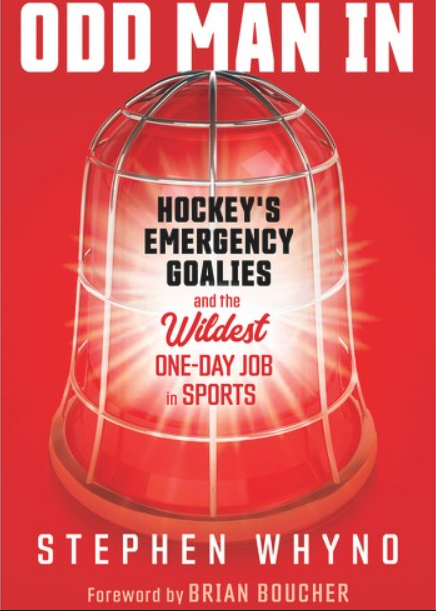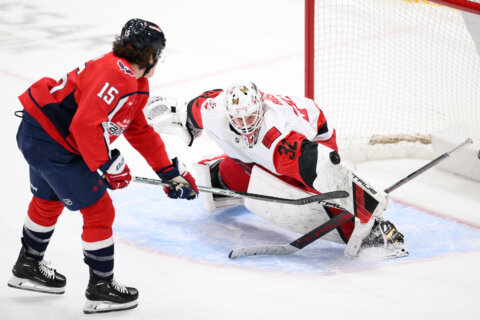Every night, in every NHL arena, there is one man who sits in the stands and knows that if things play out a certain way, that fantasy will become reality.
They’re called “Emergency Backup Goaltenders,” or “EBUGs,” for short. These hockey understudies are the subject of Stephen Whyno’s book, “Odd Man In: Hockey’s Emergency Goalies and the Wildest One-Day Job in Sports.”

Whyno attended the University of Maryland and covered the NHL in Canada before returning to the D.C. area in 2016, where his byline has regularly appeared on Capitals and Washington Football Associated Press wire stories.
He joined the WTOP sports staff on the D.C. Sports Huddle to talk about the strange protocol that’s in place in case either team loses both of its goaltenders during the course of a game.
“There’s no other thing in sports where you literally have a guy sitting in the stands who can come in and play in that league,” Whyno said. “Like, [in the NFL,] if Brady and Rodgers are playing in a game and both get hurt, you don’t have a D3 quarterback in the stands. The fact that hockey has this thing, it’s the craziest, stupidest, most wonderful thing in sports.”
Since 2015, the league has required each team to have a pool of emergency backup goaltenders, and four EBUG’s have actually set foot on the ice for regulation action.
How does one enter consideration? “Half of the time it’s all on the local rink,” Whyno said. “Saying ‘who you got who’s willing to come to a game and be ready to play and dress for us tonight.'”
The Washington Capitals haven’t played any of these impromptu understudies, but they have had to draw from the well to dress an EBUG more than once.
“The Caps have had a couple of them. Brett Leonhardt, who’s now their video coach, dressed for warm-ups in a game, I think 15 years ago, at this point, and got to take shots from Alex Ovechkin and Nicklas Backstrom,” Whyno said.
“Gavin McHale, in Winnipeg, dressed three months before they won the Stanley Cup. He’s in their locker room celebrating a win in Winnipeg and all of a sudden he watches his team for a night win the Stanley Cup — that’s pretty cool.”
David Ayres was a Zamboni driver, Scott Foster was an accountant, Tom Hodges was a life insurance salesman, and Jorge Alves was the Carolina Hurricanes’ equipment manager. Each of them got the call and actually ended up playing in an NHL game.
How do they handle knowing they might be setting foot on the ice? “There are guys who went about their day jobs and went to the gym, did their thing, and just went to the arena and then went home,” Whyno said. “And there were guys who literally couldn’t work all day, and they were freaking out all day about the idea of even being in the arena and being two injuries away and how intense that situation is.”
It’s an odd set of circumstances, but Whyno said the goalie position lends itself to unordinary situations
“They’re all goalies and goalies are crazy,” he said. “Because if you want to have frozen rubber shot at you at 100 miles an hour, there’s something wrong with you. They all had that same kind of background, but very different kind of approaches.”
“Odd Man In: Hockey’s Emergency Goalies and the Wildest One-Day Job in Sports” is available on Barnes and Noble and Amazon’s websites.








